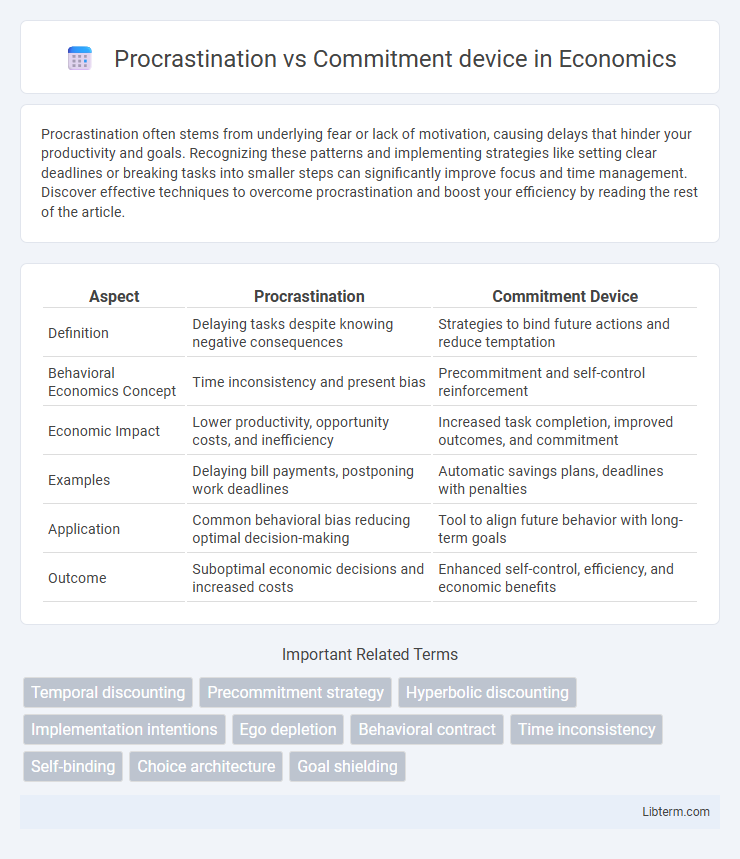Procrastination often stems from underlying fear or lack of motivation, causing delays that hinder your productivity and goals. Recognizing these patterns and implementing strategies like setting clear deadlines or breaking tasks into smaller steps can significantly improve focus and time management. Discover effective techniques to overcome procrastination and boost your efficiency by reading the rest of the article.
Table of Comparison
| Aspect | Procrastination | Commitment Device |
|---|---|---|
| Definition | Delaying tasks despite knowing negative consequences | Strategies to bind future actions and reduce temptation |
| Behavioral Economics Concept | Time inconsistency and present bias | Precommitment and self-control reinforcement |
| Economic Impact | Lower productivity, opportunity costs, and inefficiency | Increased task completion, improved outcomes, and commitment |
| Examples | Delaying bill payments, postponing work deadlines | Automatic savings plans, deadlines with penalties |
| Application | Common behavioral bias reducing optimal decision-making | Tool to align future behavior with long-term goals |
| Outcome | Suboptimal economic decisions and increased costs | Enhanced self-control, efficiency, and economic benefits |
Understanding Procrastination: Causes and Impact
Procrastination often stems from factors such as fear of failure, perfectionism, and lack of motivation, leading to delayed task initiation and impaired productivity. This behavioral pattern negatively impacts mental health by increasing stress levels and fostering feelings of guilt and anxiety. Commitment devices function as strategic tools that help individuals overcome procrastination by creating external constraints or incentives that promote timely decision-making and goal adherence.
What Is a Commitment Device?
A commitment device is a strategy or tool designed to lock in future behavior by creating consequences for failing to follow through on intentions, effectively reducing procrastination. Examples include automatic savings plans, deadlines, or accountability partnerships that limit temptation and reinforce discipline. By making it costly or difficult to back out, commitment devices increase the likelihood of goal achievement and help overcome the inertia of procrastination.
The Psychology Behind Procrastination
Procrastination often stems from an emotional regulation failure where immediate mood repair overrides long-term goal pursuit, leading to task avoidance despite awareness of negative consequences. Commitment devices leverage this insight by creating external constraints or incentives that align short-term behavior with long-term intentions, effectively reducing the opportunity to procrastinate. The psychology behind procrastination highlights the tension between impulsive urges and reflective self-control, making commitment devices crucial tools in managing time-inconsistent preferences.
Types of Commitment Devices
Commitment devices include financial penalties, such as deposits forfeited upon failure, and social contracts that leverage peer accountability to reduce procrastination. Behavioral tools like pre-commitment strategies lock decisions in advance, limiting options that enable delay. Time management apps and goal-setting frameworks act as digital commitment devices, providing structured deadlines and progress tracking to enhance task completion.
Comparing Procrastination and Commitment Device Mechanisms
Procrastination involves the tendency to delay tasks despite potential negative consequences, driven by short-term temptations and lack of self-control. Commitment devices are strategic tools or agreements designed to lock individuals into a future course of action, mitigating procrastination by increasing immediate costs or reducing temptations. Comparing these mechanisms highlights procrastination as a failure of willpower, while commitment devices function as pre-emptive systems to enforce discipline and enhance goal adherence.
Benefits of Using Commitment Devices for Productivity
Commitment devices enhance productivity by creating external accountability that reduces procrastination. These mechanisms, such as deadlines, penalties, or pre-commitments, leverage behavioral economics principles to align short-term actions with long-term goals. By limiting impulsivity and increasing motivation, commitment devices effectively help individuals maintain focus and complete tasks on time.
Common Examples of Commitment Devices
Common examples of commitment devices include automatic savings plans, where funds are directly deducted from a paycheck to prevent impulsive spending, gym memberships that require upfront payment to encourage regular exercise, and smartphone apps that block distracting websites during work hours. These tools combat procrastination by creating external constraints or incentives that align short-term actions with long-term goals. By leveraging commitment devices, individuals reduce the temptation to delay important tasks and increase their chances of maintaining consistent progress.
Overcoming Procrastination with Commitment Strategies
Overcoming procrastination often involves leveraging commitment devices that create tangible consequences for inaction, thereby enhancing motivation and follow-through. Techniques such as pre-commitment contracts, where individuals set deadlines or penalties in advance, reduce decision fatigue and increase accountability. Research in behavioral economics highlights that these commitment strategies significantly improve goal attainment by aligning short-term incentives with long-term objectives.
Potential Pitfalls of Commitment Devices
Commitment devices are designed to reduce procrastination by restricting future choices and enforcing accountability, but they carry potential pitfalls such as overcommitment and reduced flexibility. Users may face unintended consequences if circumstances change, leading to stress or suboptimal decisions when the commitment is too rigid. Furthermore, commitment devices can fail if not properly tailored to individual motivation, resulting in persistent procrastination despite the imposed constraints.
Choosing the Right Commitment Device for You
Selecting the right commitment device depends on understanding your procrastination triggers and goal specificity. Effective commitment devices range from self-imposed deadlines and financial stakes to social accountability mechanisms like public commitments or accountability partners. Tailoring the device to your motivation style and environment significantly enhances your ability to overcome procrastination and maintain long-term commitment.
Procrastination Infographic

 libterm.com
libterm.com